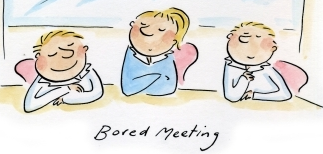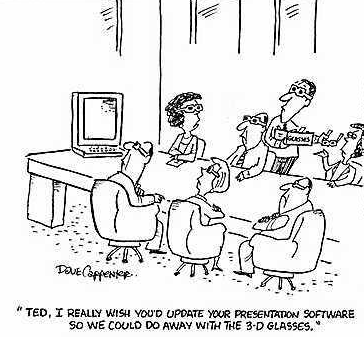
Running effective meetings is a skill that takes knowledge and practice to develop. Running an effective meeting is more than sending out a notice that your team is to meet at a particular time and place. Effective meetings need structure and order. Without these elements they can go on forever and not accomplish a thing. With a solid objective in mind, a tight agenda, and a commitment to involving the meeting participants in the planning, preparation, and execution of the meeting, you are well on your way to chairing great meetings. Given the frustration most people feel when their time is wasted, gaining a reputation for running efficient and successful meetings is good for you and your career.
There are several basic types of meeting, and each one is distinguished by a different purpose.
- In a problem-solving meeting, participants first define a problem and then craft solutions for solving it. Participants in this type of meeting must be able to recognize the problem and also have the energy and expertise to correct it. Problem solving
- . In a decision-making meeting, the group selects a solution to implement. To be successful, the group must agree on the decision-making process: will decisions be made by consensus, by majority vote, or will only certain individuals have input?Decision making
- Information giving and receiving. Other types of meetings are held for the purposes of communicating, reporting, and feedback. A status meeting for a project is designed to keep everyone on the team informed of the most recent developments.
To ensure you cover only what needs to be covered and you stick to relevant activities, you need to create an agenda. The agenda is what you will refer to in order to keep the meeting running on target and on time. To prepare an agenda, consider the following factors:
- Priorities – what absolutely must be covered?
- Results – what do need to accomplish at the meeting?
- Participants – who needs to attend the meeting for it to be successful?
- Sequence – in what order will you cover the topics?
- Timing – how much time will spend on each topic?
- Date and Time – when will the meeting take place?
- Place – where will the meeting take place?
Once you have an agenda prepared, you need to circulate it to the participants and get their feedback and input. Running a meeting is not a dictatorial role: You have to be participative right from the start. Perhaps there is something important that a team member has to add. Maybe you have allotted too much, or too little, time for a particular item. There may even be some points you've included that have been settled already and can be taken off the list for discussion.
[youtube:z6536UbT_QA]
Solution on how to have effective meetings:
- Have a good based agenda.
- Send required reading 3 days beforehand.
- Start on time.
- As people to stand up or remove chairs from meeting room.
- No laptops for visitors, only presenter and note taker should get one.
- Focus, note off topic comments.
- Send notes and action items ASAP.
Obviously, meetings can be held for more than one purpose. Staff meetings, for example, often serve both to provide updated information and to solve specific problems. But whether there is one purpose or several, it is the purpose that determines when to call a meeting. In general, call a meeting when you:
- Need the entire group to provide information or advice.
- Want the team to participate in making a decision or solving a problem.
- Want to share information, a success, or a concern with the whole group, or make everyone aware of a particular situation.
- Are dealing with a problem that needs input from members of different groups with varying perspectives or agendas.
- Find that responsibility for a problem, issue, or area needs to be clarified.
- Learn that the group feels a strong need to meet.
- Make sure the meeting is necessary.
- Involve the right people.
- Prepare for the discussion and the decisions to be made.
- Start with the easy items. Early success often promotes future success.
- Hold the more difficult items until later. But make sure to leave enough time to address them.
- Communicate clearly. Clearly articulate decisions, action items, and next steps to wrap-up each section of the meeting.
- Provide a status update. Tell your participants where they're going; tell them where they are; and tell them where they've been.
- Make a commitment to end on time.
Common Mistakes:
If you notice that the group is repeating points already made, you can: Keep track of ideas on a flip chart or white board. Be sure to confirm your understanding of the ideas presented. When someone begins to repeat an already listed idea, point to the chart or board and ask something like, "Have we got that point here? Is there something new you want to add?"
Silence can indicate a range of experiences including thoughtfulness, confusion, and boredom. If the group falls silent, you can: Let it be silent for a minute. Check out what’s happening by asking people are thinking. Ask people if they would like you to clarify something. Ask them if you are unaware of a key point or issue or if you have caused some confusion. Wait before giving them a suggestion. Don't fill in the silence too quickly. Make sure your behavior is not the problem. Break into smaller groups to encourage more participation.
When conflict arises, you can: Focus on the substance of ideas or opinions—not on the contributor's personal style or status in the organization. Encourage members to keep their comments positive and constructive and to try to see all sides of a contentious issue. Keep members from evaluating ideas too quickly. For example, when members seem to be touchy about each other's suggestions, one thing you can say is, "Now there's an idea. Let's not evaluate it just yet. Just let me write it down and add others later." Use probing questions to steer members away from entrenched positions and to help uncover the underlying issues.
Reference:
Summary:
Do your homework before a meeting: Collect relevant documents and data. Talk to the participants about their opinions and objectives. Encourage participants to do their homework and let them know your interest in their ideas. Brief your manager and other senior managers or executives who won't be at the meeting but have an interest in its outcome. Circulate the agenda and pertinent background information. After the meeting is over, take some time to debrief, and determine what went well and what could have been done better. Evaluate the meeting's effectiveness based on how well you met the objective. This will help you continue to improve your process of running effective meetings. How to end meeting?
- Restate or summarize what has been accomplished, any key points or decisions, and explain how they will be communicated to stakeholders.
- Consider keeping a shared record (e-mail or written) of action items and/or conversations to help clarify agreements.
- Schedule another meeting, if appropriate.
- Ask the group to help evaluate the meeting and get ideas for what to do better at the next meeting.
- Thank everyone for participating.
